Architecture at a juncture
China gave the world the Great Wall, pagoda roofs, screens, joints and other innovations of garden architecture. Yet that was centuries ago. Since then, China has been renowned for its concrete blocks. As the country turns to world-class talent to remake the Middle Kingdom as a modern showpiece, can China really replace crass with class?
By Ron Gluckman /Beijing, Shanghai, Chengdu and Hong Kong
PAUL ANDREU PONDERS what has become of his dream of giving Beijing a National Theater that would be the envy of the world. "The Big Hole - yes, that would be a very apt name," the French architect says as he scans the partly excavated site alongside Tiananmen Square in the Chinese capital.
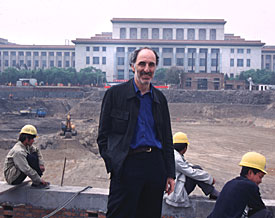 Andreu's
vision - a $300-million structure that is not so much a building as it is a
futuristic bubble set in an artificial lake - has been repeatedly stalled by
objections of Beijingers who derisively refer to it as the "alien
egg." Others have not been so kind calling it a "Giant Turd."
Andreu's
vision - a $300-million structure that is not so much a building as it is a
futuristic bubble set in an artificial lake - has been repeatedly stalled by
objections of Beijingers who derisively refer to it as the "alien
egg." Others have not been so kind calling it a "Giant Turd."
A series of project reviews have hampered development and no official date is set for completion. Andreu is undeterred. "This will be my most successful work," he predicts.
"Look at Sydney's Opera House. It's now considered an icon for the whole world. But during the process, it was much the same as this. So much controversy."
Nobody would know that better than Andreu, who has been dogged not only by bad press, but regular halts to the project whenever the public controversy grows too heated. One round of recent scrutiny by a panel of Chinese architects and designers not only delayed the project by as much as a year, but resulted in one of four theaters being trimmed from the egg over spiraling cost concerns.
Still, Andreu realizes "this is my life's work. Although renowned for his design of airports around the globe, China has given him a chance to stretch out; he's also done a sports stadium in southern China. But nothing ever on the scale of this grand theater. And few other countries would entertain such an outlandish project beyond the sketch-and-vague-proposal stage.
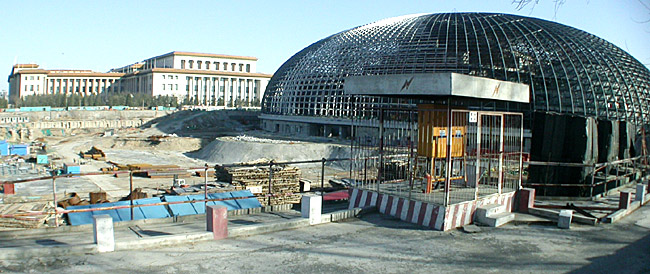 Following on the heels of a 1990s building
boom, mainland cities are once again in a state of architectural ferment.
Government officials and developers are tearing down plodding Stalinist bunkers
and rethinking the cookie-cutter chrome and glass towers that heralded the
country's embrace of capitalism.
Following on the heels of a 1990s building
boom, mainland cities are once again in a state of architectural ferment.
Government officials and developers are tearing down plodding Stalinist bunkers
and rethinking the cookie-cutter chrome and glass towers that heralded the
country's embrace of capitalism.
Frenetic construction is the next leg of a rebirthing process that can be traced at least as far back as the 1950s, when Communist leaders began tearing down Beijing's landmark city walls and swept away feudal traditions - along with the country's elegant aesthetics.
Then, China was bent on creating a more modern socialist state. Now the country is racing again to be modern, clearing land for utopian, cutting-edge designs like the National Theater - edifices meant to outdazzle anything in the West.
Just as the country is lurching toward some blurry ideal of a quasi-capitalistic economy, so too is it groping for a sense of national identity in its architecture. Experimentation and grand dreams are encouraged.
"China is like a fresh source of vitality," says 66-year-old Meinhard von Gerkan, a German whose concepts for planned communities are under consideration by the officials of several Chinese cities. "Europe is all finished," he says. "Here you have the freedom to build."
For some of the world's top architects, the country offers incomparable opportunity. Topping the roll call of the architectural stars who are drumming up Middle Kingdom business include the fabled Pei family, which just completed Bank of China's new Beijing headquarters and has, among other projects, drafted a master plan to redevelop Chengdu's Tianfu Square, second in size only to Tiananmen.
Michael Graves, perhaps the only architect ever named GQ Man of the Year (1997) has ambitious plans for the modern refurbishing of an old brownstone along Shanghai's Bund (the waterfront area that was China's Wall Street).
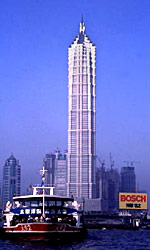 Then there are the huge firms.
Skidmore Owens & Merrill, which
practically invented the skyscraper, branding skylines around the world with its
distinctive towers for several decades, has done the same for Pudong,
near Shanghai, with China's tallest building, the $540-million, 88-story Jin Mao
Building (at left), which houses the world's highest hotel.
Then there are the huge firms.
Skidmore Owens & Merrill, which
practically invented the skyscraper, branding skylines around the world with its
distinctive towers for several decades, has done the same for Pudong,
near Shanghai, with China's tallest building, the $540-million, 88-story Jin Mao
Building (at left), which houses the world's highest hotel.
Kohn Pederson Fox, creators of New York's World Bank Headquarters and Rockefeller Plaza West, has several projects under discussion, including a 182-hectare site on the outskirts of Beijing. Commissioned by Chinese pharmaceutical giant San Jiu, this mega-town would mix research and agricultural areas with housing and services for up to 10,000 people.
Foreign architects aren't necessarily making a lot of money. Corruption, construction snafus, and bureaucratic meddling make property development a dicey game in China. Many say they are there despite the difficulties because they are being offered a chance to create signature masterworks. The country has been laid out for them like a blank canvas, a muse for their most ambitious architectural visions.
Plans on drawing boards include space age cyber-cities, cloud-topping sky-rises, and suburbs based on Venice, Amsterdam and ancient Athens. Dutch firm Kuiper Compagnons recently won a competition for a community set on canals outside Shanghai.
Kohn Pederson Fox designed the $600-million World Financial Center, scheduled to be the world's tallest building when it opens near Shanghai in 2003 or 2004. The 95-story tower will be so high that a huge circular section will be cut through the top to relieve wind pressure.
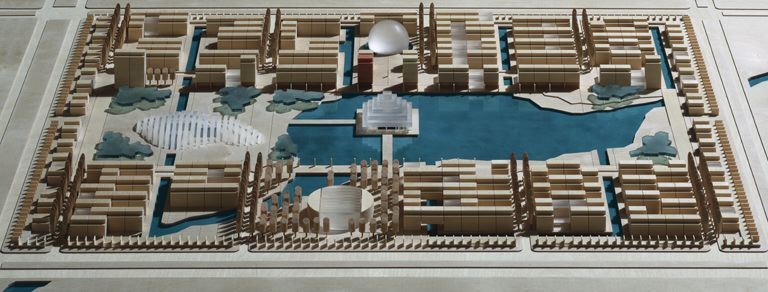 Many
of the projects are too ambitious for a poor country. They will never be built.
But the anything-goes atmosphere is "amazing," says von Gerkan as he
unveils drawings of a science city filled with observatories, museums and a
pyramid-shaped civic plaza.
Many
of the projects are too ambitious for a poor country. They will never be built.
But the anything-goes atmosphere is "amazing," says von Gerkan as he
unveils drawings of a science city filled with observatories, museums and a
pyramid-shaped civic plaza.
Officials for the new town of Lang Fang, located 70 km from Beijing, approached von Gerkan for a basic outline of a new community. He produced sketches for a lakeside metropolis that on paper look like an updated Aztec capital.
"They gave us absolutely no instructions," says von Gerkan. "They just told us, 'Give us ideas for a place like nowhere else in the world.'"
Von Gerkan recently signed a contract for a $320-million exhibition center in Shenzhen to be completed in 2003. He's due to finish a daring $58-million convention complex in Nanning the same year.
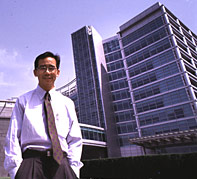 "There are things you can
do here that in America, people would throw up their hands and say, 'No way!'
" says Skidmore Owens & Merrill architect Brian Lee, who designed the
Beijing headquarters for the Industrial and Commercial Bank of China (at left),
the country's largest
bank. "It's an exciting place to work."
"There are things you can
do here that in America, people would throw up their hands and say, 'No way!'
" says Skidmore Owens & Merrill architect Brian Lee, who designed the
Beijing headquarters for the Industrial and Commercial Bank of China (at left),
the country's largest
bank. "It's an exciting place to work."
Freedom is a reflection of broader socio-economic trends. With entry into the World Trade Organization and Beijing's hosting of the 2008 Olympics ahead, mainlanders are eager to demonstrate they are on par with industrialized nations, says Jeffrey Cody, associate professor of architecture at Chinese University of Hong Kong.
Not just on par with - ahead of. "The people's tastes are no longer satisfied with the commercial and retail architecture that was common in the late 1980s and early 1990s," Cody says. "At the time, it was common to see offices with a great deal of blue glass and cheap chrome, buildings that looked like children's toys."
 Indeed, Shanghai's
high-tech district of Pudong, described in Wired magazine as "the site of
the wildest and most ambitious construction boom of the 1990s," is to some
a proto-city parody - its most visible landmark is the Oriental Pearl Tower, a
300-meter-high spire that resembles a giant sci-fi movie prop.
Indeed, Shanghai's
high-tech district of Pudong, described in Wired magazine as "the site of
the wildest and most ambitious construction boom of the 1990s," is to some
a proto-city parody - its most visible landmark is the Oriental Pearl Tower, a
300-meter-high spire that resembles a giant sci-fi movie prop.
Pudong "is ghastly," says Graves, the American architect and designer of themed Disney hotels. Graves has a personal reason to lament the soaring gaffes of Pudong. He is restoring an old brownstone along Shanghai's Bund, a row of graceful colonialist-era stone buildings often cited as the zenith of Western architecture in China.
Graves' beloved Bund arcs along the Huangpu River, almost directly opposite the Oriental Pearl Tower. "There's this thrust in China's mind to be modern," Graves says. "But the influences are the worst of the West."
This physical face-off between old and new Shanghai is just one of many conflicts between traditional and contemporary arising from mainland redevelopment. I.M. Pei, designer of the Louvre pyramid in Paris, mourns the disappearance of some of Beijing's greatest architectural treasures: the hutongs - ancient alleys filled with courtyard houses.
Several blocks of these neglected but historically rich structures are being demolished every day, their occupants normally banished to soulless suburban high-rises. "It's really too late," says Pei. "It's going this way and it's too late to change."
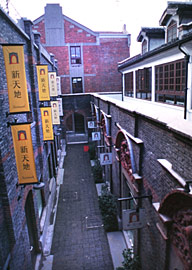 If there is no going back, then China
needs to find a way forward
that retains the country's unique architectural heritage. That, at least, is the
hope of some like Pei as well as Boston architect Benjamin Woods, widely praised
for his sensitive redevelopment of a neighborhood of traditional row houses in
Shanghai.
If there is no going back, then China
needs to find a way forward
that retains the country's unique architectural heritage. That, at least, is the
hope of some like Pei as well as Boston architect Benjamin Woods, widely praised
for his sensitive redevelopment of a neighborhood of traditional row houses in
Shanghai.
Dubbed Xin Tian Di, the district of pubs, restaurants and art galleries reminiscent of Ghirardelli Square in San Francisco, has been mobbed since its opening in mid-2001, and the reception speaks reams about the difference between government-conceived "fun districts" and the real thing.
"People said it wouldn't work, that the Chinese want modern, not old shopping centers," concedes the Burly American architect. "But I saw that they like to be outdoors and sit under trees."
Still, Pei and Woods, with their low-key approaches and reverence for tradition, are the exception. For every classy historical renovation, there are scores more neighborhoods being razed to build flashy glass towers. "China does have a certain infatuation with flash architecture," says Lee.
Ironically, the job of designing 21st century China has largely been turned over to non-Chinese. There's little room for local architects in the master plan. In the same way that a foreign suit is more prestigious than a local one, city planners want Western signatures on their blueprints.
China's emerging group of domestic architects "just haven't had the experience, the exposure," says Barry Ball, 50, chief architect with H.K.I. Development, which has the first rights to development in Beijing's Central Business District.
While mainlanders share a unique architectural heritage, few people - including architects - have had an opportunity to absorb it. The best buildings of the past, such as the Forbidden City, served royalty, not the masses. "Students tend to copy things without knowing how they work," Ball says. "It's understandable, because the majority have only seen the buildings in magazines."
In practice, the wholesale use of foreign experts affords plenty of opportunity for cultural friction to develop. Andreu's National Theater, the largest and most visionary construction project in central Beijing for a quarter of a century, is a case in point.
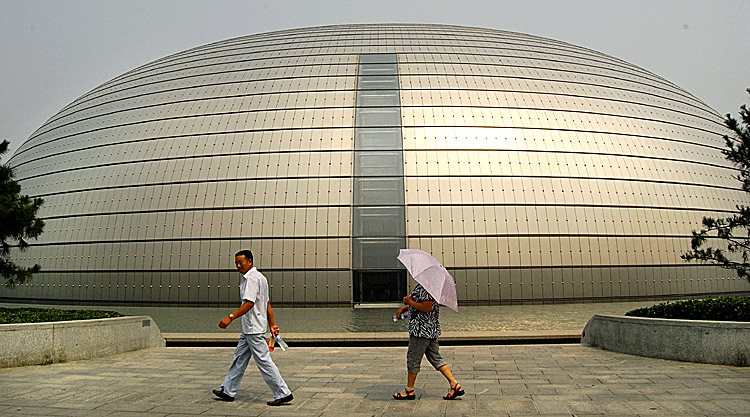
The size of several football fields, the site will house three auditoriums inside a 56-meter-high translucent glass and titanium dome that appears to float on water. Visitors will descend via escalators through the water into an underground lobby.
"I consider this the big chance of my life," says Andreu, 51, one of the world's foremost designers of airports. "To be right here, in the center of this city, the capital of China, is a very big responsibility. People will come from all over the country to see this building."
And they will be distracted by it. The alien egg is dogged by controversy because it will hatch within the sight-lines of The Great Hall of the People, Tiananmen Square and the Forbidden City, the country's most lasting monuments. Party cadres are divided over the wisdom of allowing a foreigner to dig around in the communist heartland.
As that debate rages behind the scenes, local architects and others criticize the design as too expensive ($550 million, according to some estimates; $300 million, says Andreu) and not Chinese enough. "Opponents use every argument, whether true or not," the architect complains.
But "while many people see it as a high-quality design, it seems in many ways to have very little to do with the context [of Beijing]," says Cody, the Chinese University of Hong Kong professor, who is researching the mainland's architectural history. "Andreu feels that he is being very wronged, but most people feel he has missed the balance between being up-to-date and creating something that resonates with the people."
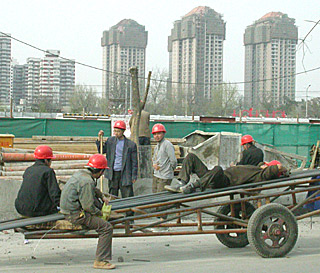 The outcry has delayed the
project's completion indefinitely. Construction delays, the bane of developers
everywhere, are not the only traps awaiting China's refurbishers. Architectural
fees are typically 20% to 30% of those in the West - and there is no guarantee
of being paid.
The outcry has delayed the
project's completion indefinitely. Construction delays, the bane of developers
everywhere, are not the only traps awaiting China's refurbishers. Architectural
fees are typically 20% to 30% of those in the West - and there is no guarantee
of being paid.
"I tell newcomers to get half up-front," says an experienced hand who asked not to be identified. "Developers often go bankrupt, so there is nothing left to go around at the end." Foreign firms are not permitted by law to do the complete design of a building, so some of the work is allocated to a local. But when money is tight - which is often - the bulk of the project shifts to the less experienced, less expensive Chinese architect.
"That cheapens the quality," says Ball. "The danger is you have an incredibly good design, but the detail disappears." Other perils: There is risk that plans, once unveiled, will be stolen and resold without the architect's authorization.
Too, regulations often work against world-class standards. The principal problem is that the contractor - a state agency - controls every project. "That's wrong," says Tao Ho, Hong Kong's best-known architect. "The architect should be on top. Otherwise, you have no quality."
Ho, 65, speaks from sour experience. In the 1980s, his firm of Great Earth Architects & Engineers International produced master plans for three Chinese cities: Xiamen, Qingdao and Hangzhou. With execution out of Tao's hands, he found his suggestions on development strategies, traffic grids and other urban ideals were largely ignored. "You don't see much there," he admits.
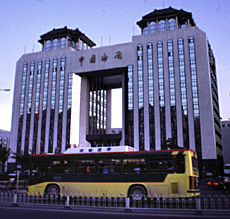 Nor, he acknowledges ruefully, do people see much of his
vision for the exterior of the China Construction Bank in Beijing. The developer
wrapped the building in Darth Vader-type dark glass, instead of the translucent
green glass Tao proposed. "The difference is night and day," he sighs.
"But in China there is little an architect can say."
Nor, he acknowledges ruefully, do people see much of his
vision for the exterior of the China Construction Bank in Beijing. The developer
wrapped the building in Darth Vader-type dark glass, instead of the translucent
green glass Tao proposed. "The difference is night and day," he sighs.
"But in China there is little an architect can say."
Adds von Gerkan, the German architect: "Sometimes you feel like a dancing bear. They need your name for publicity purposes, and then they get the design and go elsewhere. They don't realize how it changes things. It's like the difference between a Mercedes and the image of a Mercedes. You don't know it when you see it, but you know it when you drive it."
Still, there is progress being made. "There is no market premium for great architecture in China, not yet," says Rob Walker, 33, Beijing managing director of commercial property leasing agency Jones Lang LaSalle.
Case in point, the procession of gaudy modern structures along Beijing's showcase boulevard. It's called Chang An, but many joke that it might be dubbed the Architectural Hall of Shame. Some interesting concepts are attempted, but too many buildings try to do too much, cutouts and curves, pagoda roofs that clash with modern glass. It's row after row of kitschy flash (two exampled here) with little sense of subtlety or substance.
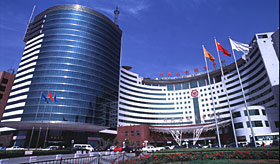 Is that
likely to change soon? Perhaps as the next phase of development puts a premium
on class. "What is just starting to hit the market is polish," Walker
says, "buildings with the right corporate image."
Is that
likely to change soon? Perhaps as the next phase of development puts a premium
on class. "What is just starting to hit the market is polish," Walker
says, "buildings with the right corporate image."
Moreover, a generation of local architects who have been educated abroad is coming of age. "The foreign moon is not always better than the moon in China," says Ma Guoxin, 59, chief architect with the Beijing Architectural Design Institute.
Respect for traditional Chinese disciplines - such as the relationship between man and nature - can turn Western concepts into something uniquely Chinese, says Ma, who in the early 1980s was visiting scholar at architect Kenzo Tange's office in Japan. He doesn't worry that Chinese aesthetics will be crowded out in the rush to modernize. The foreign invasion will help locals learn new techniques, he believes, leading to cross-fertilization and, ultimately, the emergence of a modern Chinese architectural style.
"Our traditional culture is so strong, it can never be overpowered," he says.
Even I.M. Pei, a critic of China's architectural legacy, believes the frenzied building will cease and some kind of balance will prevail. That's probably years away. With any luck, Paul Andreu will have finished his National Theater by then.
Ron Gluckman is an American reporter who has been living since 1990 in Asia, roaming around the region a number of publications, such as Asiaweek, which ran his package on architecture in China in August 2001. Extra reporting by Asiaweek included..
See also related story on famous Chinese-born architect I.M. Pei.
For an updated view of architecture in the Chinese capital, see Beijing: Bold? Brazen?
Rendition of Lang Fang city project
from office of the architect.
All other pictures by Ron Gluckman
To return to the opening page and index
push here
[right.htm]
